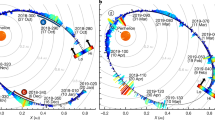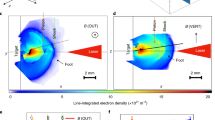Abstract
The solar wind blows an immense magnetic bubble, the heliosphere, in the local interstellar medium (mostly neutral gas) flowing by the Sun1. Recent measurements by Voyager 2 across the termination shock, where the solar wind is slowed to subsonic speeds before entering the heliosheath, found that the shocked solar wind plasma2 contains only ∼20 per cent of the energy released by the termination shock, whereas energetic particles3 above ∼28 keV contain only ∼10 per cent; ∼70 per cent of the energy is unaccounted for, leading to speculation2,3 that the unmeasured pickup ions or energetic particles below 28 keV contain the missing energy. Here we report the detection and mapping of heliosheath energetic (∼4–20 keV) neutral atoms produced by charge exchange of suprathermal ions with interstellar neutral atoms. The energetic neutral atoms come from a source ∼60° wide in longitude straddling the direction of the local interstellar medium. Their energy spectra resemble those of solar wind pickup ions, but with a knee at ∼11 keV instead of ∼4 keV, indicating that their parent ions are pickup ions energized by the termination shock. These termination-shock-energized pickup ions contain the missing ∼70 per cent of the energy dissipated in the termination shock, and they dominate the pressure in the heliosheath.
This is a preview of subscription content, access via your institution
Access options
Subscribe to this journal
Receive 51 print issues and online access
$199.00 per year
only $3.90 per issue
Buy this article
- Purchase on Springer Link
- Instant access to full article PDF
Prices may be subject to local taxes which are calculated during checkout




Similar content being viewed by others
References
Axford, W. I. et al. in Solar Wind (eds Sonett, G. P., Coleman, P. J. Jr & Wilcox, J. M.) 609–660 (Spec. Publ. 308, NASA, Washington DC, 1972)
Richardson, J. D., Kasper, J. C., Wang, C., Belcher, J. W. & Lazarus, A. J. Cool heliosheath plasma and deceleration of the upstream solar wind at the termination shock. Nature 10.1038/nature07024 (this issue)
Decker, R. B. et al. Mediation of the solar wind termination shock by non-thermal ions. Nature 10.1038/nature07030 (this issue)
Gruntman, M. et al. Energetic neutral atom imaging of the heliospheric boundary region. J. Geophys. Res. 106, 15767–15781 (2001)
Lin, R. P. et al. The STEREO IMPACT Suprathermal Electron (STE) instrument. Space Sci. Rev. 10.1007/s11214-008-9330-7 (in the press)
Luhmann, J. G. et al. STEREO IMPACT investigation goals, measurements, and data products overview. Space Sci. Rev. 10.1007/s11214-007-9170-x (in the press)
Heerikhuisen, J. et al. The effects of global heliospheric asymmetries on energetic neutral atom sky maps. Astrophys. J. 655, L53–L56 (2007)
Hilchenbach, M. et al. Detection of 55–80 keV hydrogen atoms of heliospheric origin by CELIAS/HSTOF on SOHO. Astrophys. J. 503, 916–922 (1998)
Galli, A. et al. Direct measurements of energetic neutral hydrogen in the interplanetary medium. Astrophys. J. 644, 1317–1325 (2006)
Wurz, P. et al. in Physics of the Inner Heliosheath (eds Heerikhuisen, J., Florinski, V., Zank, G. P. & Pogorelov, N. V.) 269–275 (AIP Conf. Proc. 858, AIP, New York, 2006)
Collier, M. R. et al. An unexplained 10–40° shift in the location of some diverse neutral atom data at 1 AU. Adv. Space Res. 34, 166–171 (2004)
Witte, M. et al. Kinetic parameters of interstellar neutral helium: Final results from the ULYSSES/GAS Instrument. Adv. Space Res. 34, 61–65 (2004)
Gloeckler, G. et al. Observations of the helium focusing cone with pickup ions. Astron. Astrophys. 426, 845–854 (2004)
Decker, R. B. et al. in Physics of the Inner Heliosheath (eds Heerikhuisen, J., Florinski, V., Zank, G. P. & Pogorelov, N. V.) 73–78 (AIP Conf. Proc. 858, AIP, New York, 2006)
Gloeckler, G. & Fisk, L. A. in Physics of the Inner Heliosheath (eds Heerikhuisen, J., Florinski, V., Zank, G. P. & Pogorelov, N. V.) 153–158 (AIP Conf. Proc. 858, AIP, New York, 2006)
Fisk, L. A. et al. Acceleration of low-energy ions at the termination shock of the solar wind. Astrophys. J. 644, 631–637 (2006)
Richardson, J. D., Paularena, K. I., Lazarus, A. J. & Belcher, J. W. Evidence for a solar wind slowdown in the outer heliosphere? Geophys. Res. Lett. 22, 1469–1472 (1995)
Burlaga, L. F. et al. Magnetic fields at the solar wind termination shock. Nature 10.1038/nature07029 (this issue)
Acknowledgements
We thank R. Mewaldt for suggestions, G. Gloeckler and E. Roelof for discussions, D. Curtis for instrument development and explanations of calibration data, and the Voyager team for sharing their results before publication. This research was supported in part by the National Aeronautics and Space Administration.
Author Contributions L.W. analysed the data and wrote the paper with direction and help from R.P.L. R.P.L. designed the Suprathermal Electron instrument and is the co-investigator in charge. D.E.L. assisted with the experimental work. J.G.L. is the principal investigator of the IMPACT investigation on STEREO that includes STE.
Author information
Authors and Affiliations
Corresponding author
Supplementary information
Supplementary information
This file contains Supplementary Discussion; Supplementary Figure S1 with Legend; Supplementary Table 1 with Legend; and additional references. The Supplementary Discussion includes more detailed instrumentation for detection of energetic neutral atoms, data analysis methods and limitation. The Supplementary Figure S1 shows an example of energetic neutral atom observations by STE. The Supplementary Table 1 summarizes the changes in the energy densities and number densities of various plasma/energetic particle populations and magnetic fields across the termination shock. (PDF 258 kb)
Rights and permissions
About this article
Cite this article
Wang, L., Lin, R., Larson, D. et al. Domination of heliosheath pressure by shock-accelerated pickup ions from observations of neutral atoms. Nature 454, 81–83 (2008). https://doi.org/10.1038/nature07068
Received:
Accepted:
Issue Date:
DOI: https://doi.org/10.1038/nature07068
This article is cited by
-
IBEX Backgrounds and Signal-to-Noise Ratio
Space Science Reviews (2009)
-
A shock for Voyager 2
Nature (2008)
Comments
By submitting a comment you agree to abide by our Terms and Community Guidelines. If you find something abusive or that does not comply with our terms or guidelines please flag it as inappropriate.



